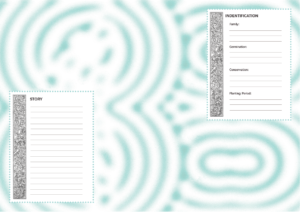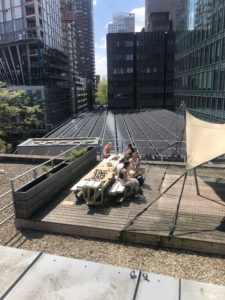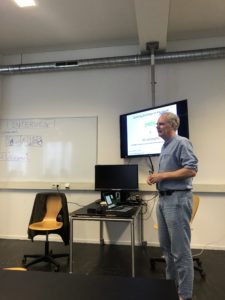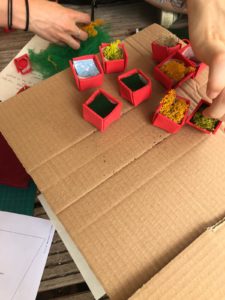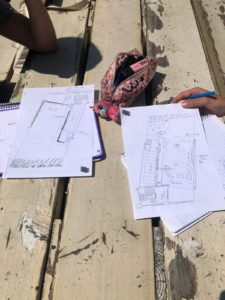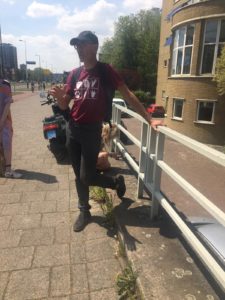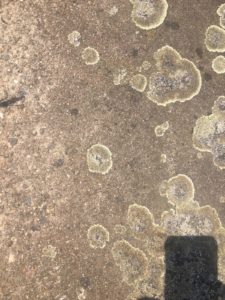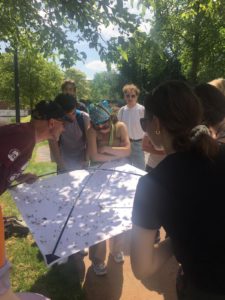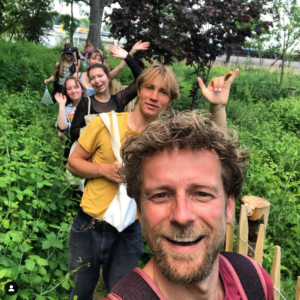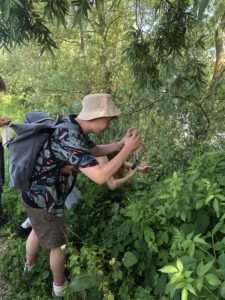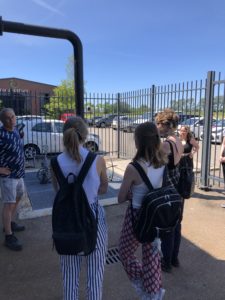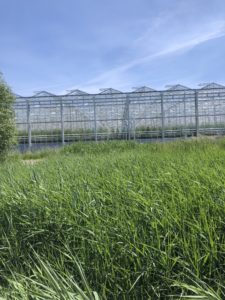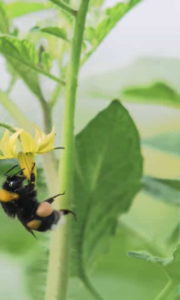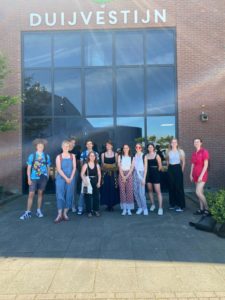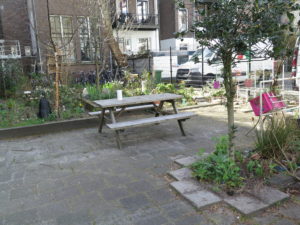- News & Events
Rooftop Garden: the start of a seed
The rooftop of WdKA is located at the Blaak building site. The first ideas to start a rooftop garden came by the student from the SPIN Collective. This collective is a student lead climate group based at the Willem de Kooning Academy. From June 7th until 11th we organised an elective in close collaboration with the SPIN Collective for 45 first and second year students from the Willem de Kooning. In this blog we share our program an some of the insight that we created and grew together.
Rooftop gardens bring different cultures together in cities. Various initiatives in Rotterdam bring functions to these rooftops with music, plants, water storage and even living on a roof. But what are important functions for the rooftop garden of the WdKA? How do you want to grow this space and community, what do you as student would like this place to be? Through making future plans for this rooftop garden, we aim to make topics such as climate change, ecology, resilience and circularity become more tangible.
But how to develop a space without experts? We invited scientists, makers and ecologists from our network to dive with us in the design of the space, the ecology of the city and future perspectives, literally from outer space. The students could pick one of the workshops offered by our experts, within this group they all came up with an idea for the rooftop garden, fed by ideas, actions and inspirations they got throughout the week.
Monday June 7th.
The day started with a stunning blue sky and the warm shades of the sun. We invited our students on the rooftop for a morning meditation. Meditation will set the tone for your entire day and help you to be focused, content, and optimistic. Since the rooftop is currently surrounded by construction sites and the ventilation vent from the academy has its output on the rooftop we encouraged the students to become one with the space, the sounds, the temperature, the smells and each other. For many of them it was the first time being together after such a long period of isolation. Are you curious about the meditation text? You can read it here: Meditation
From soil to space
After the meditation we had an interesting talk from Dr. Agata Kołodziejczyk, a Polish neurobiologist with a space mission. She obtained her doctorate at the University of Stockholm, co-founder of Space Garden and Analog Astronaut Training Center, the main originator and creator of analog bases for simulating space missions in Poland, organizer of 26 lunar and Martian analog space missions, mentor of 85 analog astronauts. She worked at the European Space Agency in the Advanced Concepts Team in the Netherlands.
With an astonishing CV, Agata took the time to tell us how we can farm in space. How do you do that when you have a completely different atmosphere? What kind of smart systems can you build and control in order to produce a specific kind of food palette? Agata introduced us in the world of bioreactors, where you can grow food in a liquid state as well as vertical farm constructions that are being explored to feed our astronauts in space. And actually, to work at ESA you don’t have to be a rocket scientist, they actually do work with designers and artists in collaborational project.
Map the Seed
The girls from SPIN Collective prepared a workshop for the students. We asked them to bring a seed and explain why they brought it. Spin provided two working documents for the students to research their specific seed and from where it originates.
Tuesday 8th: Work the workshop: on safari in the big city
Tuesday was workshop day! But before diving into the vibrant green of our own city center of Rotterdam, we got a fantastic presentation by Dr. Bert van Duijn, physiologist and biophysicist and Chief Scientific Officer and legal representative (director) at Fytagoras in Leiden.
Fytagoras is a dynamic research company. It was founded in 2006 and stems from the TNO research department “Applied Plant Sciences”. The name Fytagoras is a nod to the scientist Pythagoras and the Greek word phyto, which means plant. Expertise from Fytagoras finds its way to breeding and seed companies, food and pharmaceuticals, and the horticultural sector. Spearheads are doubled haploid technology, seed technology, extraction technology, and horticultural knowledge of the root environment in particular.
Bert explained us how humans and plants are connected. They researched the behaviour, concentration and workflow of people surrounded by plants (from plant pictures, to plastic and real plants), for example in Coca Cola’s headquarter in Rotterdam, and the influence of plants in detention center to lower violence and aggressiveness.
In the afternoon the students could participate three workshops
- Hypergarden by Jonathan Looman at the rooftop garden
- Biodiversity walk by evolutionary biologist Menno Schilthuizen in the city center of Rotterdam
- Wildpick workshop by Gydo van der Wal from Buit: eetbare natuur. at Brienenoord Eiland Rotterdam.
Biodiversity Walk by Menno Schilthuizen
Menno is an evolutionary biologist, writer and researcher connected to Naturalis Biodiversity Center in Leiden. He holds a chair in evolution at Leiden University. His research deals with the diversification of groups of closely-related species, in land snails and beetles, and the questions of how and why different body-shapes evolve rapidly in such evolutionary ‘radiations’.
In a two hour walk from the entrance of Het Nieuwe Instituut the students see several examples of urban plants and animals that have adapted to urban conditions such as the urban heat island, fragmentation of the vegetation, exotic species, impervious surfaces, pollution, and many other ways in which the urban ecosystem is different from natural ecosystems. These adaptations often involve genetic changes, which means that these species are rapidly evolving under anthropogenic pressure: high-speed evolution in the Anthropocene! The observations will offer food for thought on how we can integrate the evolving urban ecosystem in the way we plan and develop our cities.
Wildpick tour at Brienenoord Eiland
The last workshop was about our edible city. Almost all of us do it without knowing it: everyone has picked blueberries or blackberries at some point. Let’s face it, isn’t it wonderful to be outside and pick your own food? We dived into the menu of Brienenoord Eiland, one of the city’s island located directly under the A16 highway. Cleavers, thistles, dandelions, garlic-without-garlic, hogweed, wild garlic, pentecost flower, reed, rapeseed and in this season elderflower, only a selection of edibles we have found during our walk.
When Gydo opened his beach pavilion, he first became acquainted with how our food system works. The finest ingredients were grown and caught nearby. But all these delicious products were largely exported. He changed that by giving local makers, farmers and fishermen a prominent place. They also supplied most of the ingredients for the menu. Local, fresh and very tasty! His interest in sustainability and our food was piqued! And everything you pay attention to grows: in the meantime he runs Noorderwind with two partners and we realize sustainable ideas for companies, governments and schools. With Buit he wants to inspire a large group of people to get started with wild picking. Eat what nature has to offer and therefore hyper local.
After the walk you will notice that you will consciously look at your surroundings. And who knows, just like me, you might see something edible growing on every street corner! – Emma
Along the way we collect the ingredients for a delicious wild pesto. Here’s a recipe and what you need.
Wednesday 9th of June: Ted Duijvestijn Tomatoes in Pijnacker
Through the workshop, the students got aquatinted with biodiversity, local food and all the other facets of designing a rooftop, but how are the ‘big guys’ producing for for us? As an extra workshop we visited friend farmer Ted Duijvestijn who runs his family company with his brothers only 20 minutes outside of the big city. In the heat of the city, between The Hague and Rotterdam surrounded by greenhouse we were welcomed by Ted.
For more than fifty years, Duijvestijn Tomaten has been growing high quality, delicious tomatoes with passion and pride. Sustainability and innovation have always been key motivational factors and are intrinsic elements of how they operate. They currently grow on nearly 25 hectares and produce about 17 million kilos of tomatoes every year.
Did you know The Netherlands is the second biggest tomato producer on the world? Only Mexico produces more tomatoes, not in greenhouses but in open fields.
To reduce their energy consumption, as one of the first growers in the Netherlands, they decided to heat the greenhouses using geothermal energy. As a result, they use virtually no fossil fuels. This huge pipe pumps up geothermal heat from 4 kilometers deep. Thermal heat is ‘free’ and it is there. It is a state mine from the Dutch Government and therefore protected by a huge fence.
Another innovation is a vertical farming project. An ongoing research together with WUR is searching for new possibilities and innovations resulted in the start of the vertical farming project. This project involves researching different crops and growing methods.
They use bumblebees to naturally pollinate, these clever insects can communicate with each other.
Before tomatoes can start growing, the flowers on the tomato plant have to be pollinated. In the greenhouse, they use bumblebees for this purpose. The bumblebees live in special bee boxes spread strategically around the greenhouse. Just like honey bees, they collect pollen from the flowers. Why do we use bumblebees and not honey bees? Honey bees are used as pollinators with certain crops, for example many types of fruit trees. Their blossom is rich in nectar, so the bees stay close to this source. However, the flowers of tomatoes do not have a lot of nectar. The honey bees would quickly leave the greenhouse in search of richer food sources. And because bees communicate with each other, as soon as one leaves, the rest are likely to follow. Bumblebees are a little less clever and stay close to the food source. They are offered sugar water as a source of nutrition.
Would like to know more about how your tomato is farmed only 15 kilometers from Rotterdam? Visit the website.
Thursday 10th of June: get back to the city farm
To get back from all this inspirational workshops the students were asked to think about a concept for the rooftop garden. Every page contributes to the Zine that is made in close collaboration with the SPIN Collective.
The Zine imagines the vision and mission of the rooftop garden through writings, visualisations, mappings, drawings ,actions, observations, activities to be organized by and for our students.
To have a final inspiration, we invited Iris Schutte, teacher at WdKA and two students from the Piet Zwart Institute. Kate Price and Yoeri Guépin to tell about their initiatives.
EnergieKas by Iris Schutte
Iris Schutten initiates, develops, writes and teaches about transition in relation to art, design, architecture, public space and economy.
At the moment she develops EnergieKas – a rooftop greenhouse that both generates energy and functions as a tropical community garden and testing ground for regenerative design. It it a prizewinning project selected for the Energiechallenge by the city counsel of The Hague, 2019.
It is situated on top of de Helena, a catalyst for art, city and society in transition. A self-initiated project in close collaboration with Erik de Jong (Morfis).
Other partners are Langebeesten Energiek, stichting De Helena, Groene Mol, Ruimtevaart, Billytown, Laboratory for Microclimates, Refunc, wijkorganisatie het oude Centrum and Collective Works.
Gardeningatthepiet by Kate Price and Yoeri Guépin
The Piet Zwart Institute MFA studio building located at Karel Doormanhof in central Rotterdam is fortunate to contain a large garden space which has been slowly established over the last few years. A site reflective of the people who have traversed the building, from eager concierges to passionate tutors and students, it has changed and grown to be a place of experimentation, knowledge exchanges and connection. Currently the students of the MFA program and artist/gardener Yoeri Guépin are working hard within the garden to replenish the soil and plant a diverse collection of fruits and vegetables, medicinal plants and rare heirlooms. Within their talk Yoeri and Kate detailed the activities that have been taking place in the garden and their collective plans for the future.
Friday 11th of June: Spin it Up! Zine workshop
Spin facilitated – in collaboration with the publication station – a Zine workshop. Every student participating made two A4 pages compiling what they documented during the week or explaining what they learned – the content of the page is up to each person as long as it’s connected to the elective. All the pages have been printed, which resulted in a large collection of ideas on the table where students collectively made their own made zine.
Are your curious what the students came up with? View the Zine here.

